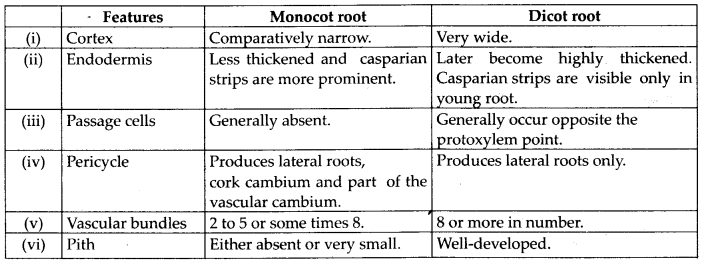NCERT Solutions Class 11 Biology Chapter 6 - Anatomy of Flowering Plants
Q1: Draw illustrations to bring out the anatomical difference between
(a) Monocot root and Dicot root
(b) Monocot stem and Dicot stem
Ans: (a) Monocot root and dicot root


(b) Monocot stem and dicot stem


Q2: Cut a transverse section of young stem of a plant from your school garden and observe it under the microscope. How would you ascertain whether it is a monocot stem or a dicot stem? Give reasons.
Ans: Vascular bundles in dicot stem are arranged in a ring whereas in monocot stem vascular bundles are scattered throughout the ground tissue. On the basis of arrangement of vascular bundles it can be ascertained whether the young stem is dicot or monocot. Besides undifferentiated ground tissue, sclerenchymatous hypodermis, oval or circular vascular bundles with Y shaped xylem are other differentiating features of monocot stem.
Q3: The transverse section of a plant material shows the following anatomical features -
(a) the vascular bundles are conjoint, scattered and surrounded by a sclerenchymatous bundle sheaths.
(b) phloem parenchyma is absent. What will you identify it as?
Ans: The monocot stem is characterised by conjoint, collateral, and closed vascular bundles, scattered in the ground tissue containing the parenchyma. Each vascular bundle is surrounded by sclerenchymatous bundle-sheath cells. Phloem parenchyma and medullary rays are absent in monocot stems.
Q4: What is stomatal apparatus? Explain the structure of stomata with a labelled diagram.
Ans: Stomata are small pores present in the epidermis of leaves. They regulate the process of transpiration and gaseous exchange. The stomatal pore is enclosed between two bean shaped guard cells. The inner walls of guard cells are thick, while the outer walls are thin. The guard cells are surrounded by subsidiary cells. These are the specialised epidermal cells present around the guard cells. The pores, the guard cells, and the subsidiary cells together constitute the stomatal apparatus.
Stomata
Q5: Name the three basic tissue systems in the flowering plants. Give the tissue names under each system.
Ans: 
Q6: How is the study of plant anatomy useful to us?
Ans: The study of plant anatomy is useful to us in the following ways:
- To understand structural adaptations in plants to different climatic conditions.
- Helpful in identifying monocots, dicots and gymnosperms.
- Physiological conditions can be studied, which helps in crop improvement.
- The study of plant fibres, such as flax, jute, etc., helps in their commercial exploitation, as it enables the prediction of the strength of wood which can be utilised to its potential.
Q7: Describe the internal structure of a dorsiventral leaf with the help of labelled diagrams.
Ans: Dorsiventral leaves are found in dicots. The vertical section of a dorsiventral leaf contains three distinct parts.
- Epidermis: Epidermis is present on both the upper surface (adaxial epidermis) and the lower surface (abaxial epidermis). The epidermis on the outside is covered with a thick cuticle. Abaxial epidermis bears more stomata than the adaxial epidermis.
- Mesophyll: Mesophyll is a tissue of the leaf present between the adaxial and abaxial epidermises. It is differentiated into the palisade parenchyma (composed of tall, compactly-placed cells) and the spongy parenchyma (comprising oval or round, loosely-arranged cells with inter cellular spaces). Mesophyll contains the chloroplasts which perform the function of photosynthesis.
- Vascular system: The vascular bundles present in leaves are conjoint and closed. They are surrounded by thick layers of bundle sheath cells.

|
150 videos|399 docs|136 tests
|
FAQs on NCERT Solutions Class 11 Biology Chapter 6 - Anatomy of Flowering Plants
| 1. What is the structure and function of a flower? |  |
| 2. How do flowers reproduce? |  |
| 3. What is the importance of flowers in the plant life cycle? |  |
| 4. How do the different parts of a flower work together during reproduction? |  |
| 5. How do flowers adapt to different environments for reproduction? |  |

















